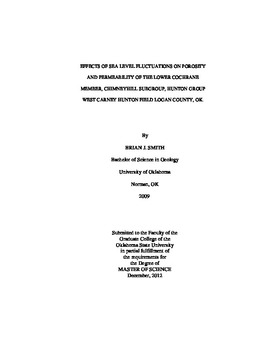| dc.contributor.author | Smith, Brian Joseph | |
| dc.date.accessioned | 2014-03-14T21:52:15Z | |
| dc.date.available | 2014-03-14T21:52:15Z | |
| dc.date.issued | 2012-12-01 | |
| dc.identifier.uri | https://hdl.handle.net/11244/8060 | |
| dc.description.abstract | The West Carney Hunton Field is located in central Oklahoma in Lincoln and Logan Counties. The field is situated on the Oklahoma Platform just east of the Nemaha Ridge. The Hunton Group was deposited in a broad, shallow epicontinental sea. Sea level fluctuations occurred throughout the early Silurian that diagenetically affected porosity and permeability of the Lower Cochrane "member" of the Chimneyhill Subgroup. Petrography (Cathodoluminescence, and light microscopy), carbon and oxygen stable isotopes, and core analysis were used to document these diagenetic affects throughout the Lower Cochrane "member". Three distinct Cathodoluminescence (CL) zones are observed in the calcite cements of the Lower Cochrane. In order from oldest to youngest these three zones are: CL zone 1 (Z1), CL zone 2 (Z2), and CL zone 3 (Z3). CL zones 1 and 2 are both composed of non-CL calcite cements that occur as open space fillings in intergranular pores and as syntaxial overgrowths on crinoid grains. CL zones 1 and 2 are typically separated by a thin bright CL subzone. CL zone 3 (Z3) is a bright to dull CL multi-banded calcite cement which occurs as the last generation of calcite cement. The distribution of these cements varies with stratigraphic position. The Z1 and Z2 calcite cements display average values of 18O = -4.4 / VPDB s.d.=1.0 / and 13C = 0.2 / VPDB s.d.=2.3 /. Z3 calcite cements display average values of 18O = -5.4 / VPDB s.d.=1.9 / and 13C = -0.2 / VPDB s.d.=1.7 /. Brachiopods display average values of 18O = -4.2 / VPDB s.d.= 0.4 / and 13C = 0.8 / VPDB s.d.= 0.8 /. CL Z1 and Z2 likely were precipitated in meteoric environments during lowstands in sea level related to glaciations during the early Silurian (early and latest Aeronian). CL Z3 calcite cements may have been precipitated in a later burial diagenetic environment. Secondary porosity and permeability are enhanced up-dip closer to exposure surfaces. However, porosity and permeability may have been better preserved in the down dip wells because of less precipitation of CL Z1 and Z2 calcite cements. Final porosity and permeability may be facies as well as diagenetically controlled. The brachiopod packstone facies in this area preserved more shelter and vuggy porosity than other facies. | |
| dc.format | application/pdf | |
| dc.language | en_US | |
| dc.publisher | Oklahoma State University | |
| dc.rights | Copyright is held by the author who has granted the Oklahoma State University Library the non-exclusive right to share this material in its institutional repository. Contact Digital Library Services at lib-dls@okstate.edu or 405-744-9161 for the permission policy on the use, reproduction or distribution of this material. | |
| dc.title | Effects of Sea Level Fluctuations on Porosity and Permeability of the Lower Cochrane Member, Chimneyhill Subgroup, Hunton Group West Carney Hunton Field Logan County, Ok | |
| dc.type | text | |
| osu.filename | Smith_okstate_0664M_12477.pdf | |
| osu.college | Arts and Sciences | |
| osu.accesstype | Open Access | |
| dc.description.department | Boone Pickens School of Geology | |
| dc.type.genre | Thesis | |
| dc.subject.keywords | cathodoluminescence | |
| dc.subject.keywords | chimneyhill subgroup | |
| dc.subject.keywords | hunton group | |
| dc.subject.keywords | porosity | |
| dc.subject.keywords | west carney hunton field | |
